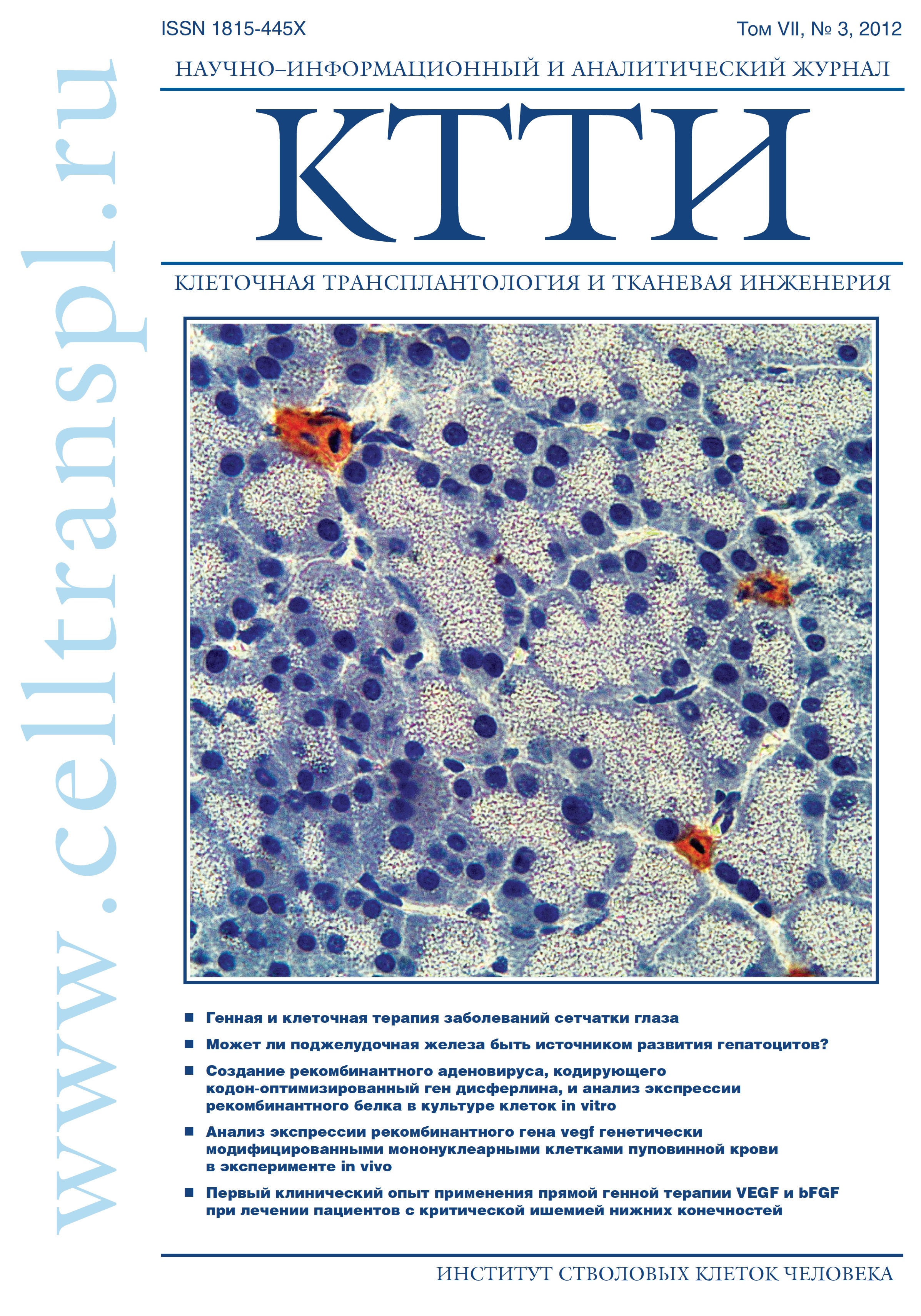Isolation and cultivation of myofibroblasts from rats liver using explantation method
- 作者: Mijanovic О1, Shafigullina АК2, Rizvanov АА1, Kiasov АP1,2,3
-
隶属关系:
- Kazan (Volga Region) Federal University, Kazan
- Kazan Sate Medical University, Kazan
- 期: 卷 7, 编号 3 (2012)
- 页面: 112-115
- 栏目: Articles
- ##submission.dateSubmitted##: 11.01.2023
- ##submission.datePublished##: 15.09.2012
- URL: https://genescells.ru/2313-1829/article/view/121632
- DOI: https://doi.org/10.23868/gc121632
- ID: 121632
如何引用文章
详细
During liver fibrosis development connective tissue
is produced by myofibroblasts that could originate from
two hepatic populations: hepatic stellate cells and portal
fibroblasts. A marker of myofibroblasts is the expression
of -smooth muscle actin (-SMA). Distinctive feature of
myofibroblasts, derived from hepatic stellate cells, is the
preservation of the hepatic stellate cells marker expression -
desmin. The processes of activation, proliferation and cells
trans-differentiation into myofibroblasts are closely related
to the activity of transcription factor NF-kB and its inhibitor
IkB. The aim of our work was to obtain a culture of hepatic
myofibrobasts, to study their origin, phenotype, relations
between NF-kB and IkB expression and the processes of
activation and cells trans-differentiation into myofibroblasts.
For this purpose we isolated heterogeneous population of
cells from rat liver by the method of explantation. Almost
all the cells had desmin and -SMA expression. On this
basis, we suppose that these myofibroblasts were hepatic
stellate cells derivatives, and singular desmin-negative cells
originated from portal fibroblasts. Thus, hepatic stellate cells
have major potential to activation, growth, proliferation and
transdifferentiation into myofibroblasts in comparison to
portal fibroblasts. Activated state of the cells was confirmed
by stable expression of NF-kB and its inhibitor IkB in all the
cells throughout the whole experiment.
is produced by myofibroblasts that could originate from
two hepatic populations: hepatic stellate cells and portal
fibroblasts. A marker of myofibroblasts is the expression
of -smooth muscle actin (-SMA). Distinctive feature of
myofibroblasts, derived from hepatic stellate cells, is the
preservation of the hepatic stellate cells marker expression -
desmin. The processes of activation, proliferation and cells
trans-differentiation into myofibroblasts are closely related
to the activity of transcription factor NF-kB and its inhibitor
IkB. The aim of our work was to obtain a culture of hepatic
myofibrobasts, to study their origin, phenotype, relations
between NF-kB and IkB expression and the processes of
activation and cells trans-differentiation into myofibroblasts.
For this purpose we isolated heterogeneous population of
cells from rat liver by the method of explantation. Almost
all the cells had desmin and -SMA expression. On this
basis, we suppose that these myofibroblasts were hepatic
stellate cells derivatives, and singular desmin-negative cells
originated from portal fibroblasts. Thus, hepatic stellate cells
have major potential to activation, growth, proliferation and
transdifferentiation into myofibroblasts in comparison to
portal fibroblasts. Activated state of the cells was confirmed
by stable expression of NF-kB and its inhibitor IkB in all the
cells throughout the whole experiment.
作者简介
О Mijanovic
Kazan (Volga Region) Federal University, KazanKazan (Volga Region) Federal University, Kazan
А Shafigullina
Kazan Sate Medical University, KazanKazan Sate Medical University, Kazan
А Rizvanov
Kazan (Volga Region) Federal University, KazanKazan (Volga Region) Federal University, Kazan
А Kiasov
Kazan (Volga Region) Federal University, Kazan;Kazan Sate Medical University, Kazan;Kazan (Volga Region) Federal University, Kazan;Kazan Sate Medical University, Kazan;
参考
- Gumerova A., Abdulkhakov S. Cell sources of liver development and regeneration. Saarbrucken: LAP LAMBERT Academic Publishing GmbH &Co.KG; 2012.
- Гумерова А.А. Киясов А.П. Могут ли перисинусоидальные клетки быть региональными стволовыми [прогениторными] клет- ками печени? Клеточная трансплантология и тканевая инженерия 2010; 5(1): 33-40.
- Ramadori G., Saile B. Mesenchymal cells in the liver - one cell type or two? Liver 2002; 22(4): 283-94.
- Iwaisako K., Brenner D.A., Kisseleva T. What's new in liver fibrosis? The origin of myofibroblasts in liver fibrosis. J. Gastroenterol. Hepatol. 2012; 27(Suppl 2): 65-8.
- Eng F.J., Friedman S.L. Transcriptional regulation in hepatic stellate cells. Semin. Liver Dis. 2001; 21(3): 385-95.
- Kisseleva T., Brenner D.A. Anti-fibrogenic strategies and the regression of fibrosis. Best Pract Res Clin Gastroenterol. 2011; 25(2): 305-17.
- Knook D.L., Seffelaar A.M., de Leeuw A.M. Fat-storing cells of the rat liver. Their isolation and purification. Exp. Cell Res. 1982; 139(2): 468-71.
- Bosselut N., Housset C., Marcelo P. et al. Distinct proteomic features of two fibrogenic liver cell populations: hepatic stellate cells and portal myofibroblasts. Proteomics 2010; 10(5): 1017-28.
- Knittel T., Kobold D., Saile B. et al. Rat liver myofibroblasts and hepatic stellate cells: different cell populations of the fibroblast lineage with fibrogenic potential. Gastroenterology 1999; 117(5): 1205-21.
补充文件








